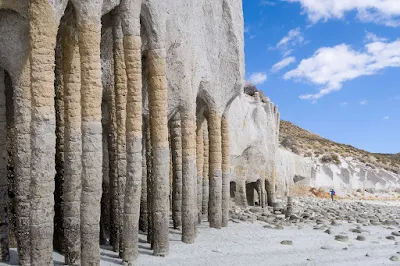Crowley Lake is a reservoir on the upper Owens River in southern Mono County, California, in the United States. Crowley Lake is 15 miles south of Mammoth Lakes.
The lake was created in 1941 by the building of the Long Valley Dam by the Los Angeles Department of Water and Power (DWP), as storage for the Los Angeles Aqueduct and for flood control. The dam is 126 feet high and impounds 183,465 acre-feet. For more on the history of the lake, see Owens Lake.
It is known for its trout fishing: Between 6,000 and 10,000 anglers hit the lake on opening day. The largest brown trout taken from the lake weighed 26 pounds. Many people from all over California head here for late summer and fall fly fishing since the lake contains some of the largest trout around. Crowley Lake Fish Camp, run in cooperation with the Los Angeles Department of Water and Power, is the only way to access the lake, and visitors can rent boats, book camping sites, and buy supplies at the Fish Camp.













The lake is named after Father John J. Crowley, “the desert Padre”, who was a key figure in Owens Valley history and a local hero. When it became obvious that the city of Los Angeles’s appropriation of the water supply had made agriculture impossible in the Owens Valley, many of the residents of the Valley lost all hope. Father Crowley traveled up and down the Valley, convincing many of them that it could become a tourist destination. Thus, it is fitting that while it exists to serve the Los Angeles aqueduct, Crowley Lake is also a prime destination for anglers. Father Crowley was killed in 1940 in an automobile accident.
Upon completion of the reservoir in 1941, strange columnar formations, some of which reached heights of as much as 20 feet, were spotted along the reservoir's eastern shore. Some described them as stone cylinders connected by fortified stone arches that had been completely covered and obscured for millions of years but which had been gradually unmasked by the incessant pummeling of the lake's powerful waves, whose constant pounding had eroded the more malleable rock at the base of the cliffs encasing these pillars. The pillars were simply regarded as oddities until 2015, when geologists realized that they were the result of frigid water from melting snow seeping down into volcanic ash (the result of a catastrophic explosion more than 700,000 years prior), creating tiny holes in the hot ash, the byproduct being boiling water and steam, which then rose up and out of these same holes. Samples of the resulting "evenly spaced convection cells similar to heat pipes" (a quote from a study at UC Berkeley) were analyzed using X-rays and electronic microscopes; and researchers found that minute crevices in these "convection pipes" were literally bonded into place by minerals that were able to resist the corrosive force of the lake's waves. Researchers have now counted nearly 5,000 of these pillars, which appear in groups and vary widely in shape, size and color over an area of 4000 acres, with some of the columns standing as erect as towering pylons and sporting ringed apertures approximately a foot apart; others which are warped or leaning at various angles; and still others that are half-submerged and, some say, resemble the petrified remains of dinosaur vertebrae.




















































